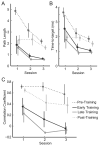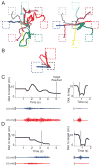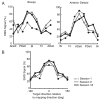Reducing Abnormal Muscle Coactivation After Stroke Using a Myoelectric-Computer Interface: A Pilot Study
- PMID: 24376069
- PMCID: PMC4074272
- DOI: 10.1177/1545968313517751
Reducing Abnormal Muscle Coactivation After Stroke Using a Myoelectric-Computer Interface: A Pilot Study
Abstract
Background A significant factor in impaired movement caused by stroke is the inability to activate muscles independently. Although the pathophysiology behind this abnormal coactivation is not clear, reducing the coactivation could improve overall arm function. A myoelectric computer interface (MCI), which maps electromyographic signals to cursor movement, could be used as a treatment to help retrain muscle activation patterns. Objective To investigate the use of MCI training to reduce abnormal muscle coactivation in chronic stroke survivors. Methods A total of 5 healthy participants and 5 stroke survivors with hemiparesis participated in multiple sessions of MCI training. The level of arm impairment in stroke survivors was assessed using the upper-extremity portion of the Fugl-Meyer Motor Assessment (FMA-UE). Participants performed isometric activations of up to 5 muscles. Activation of each muscle was mapped to different directions of cursor movement. The MCI specifically targeted 1 pair of muscles in each participant for reduction of coactivation. Results Both healthy participants and stroke survivors learned to reduce abnormal coactivation of the targeted muscles with MCI training. Out of 5 stroke survivors, 3 exhibited objective reduction in arm impairment as well (improvement in FMA-UE of 3 points in each of these patients). Conclusions These results suggest that the MCI was an effective tool in directly retraining muscle activation patterns following stroke.
Keywords: EMG; arm; coactivation; muscles; rehabilitation; stroke; synergies.
© The Author(s) 2013.
Figures





Similar articles
-
Myoelectric Computer Interface Training for Reducing Co-Activation and Enhancing Arm Movement in Chronic Stroke Survivors: A Randomized Trial.Neurorehabil Neural Repair. 2019 Apr;33(4):284-295. doi: 10.1177/1545968319834903. Epub 2019 Mar 19. Neurorehabil Neural Repair. 2019. PMID: 30888251 Free PMC article. Clinical Trial.
-
Myoelectric computer interfaces to reduce co-contraction after stroke.Annu Int Conf IEEE Eng Med Biol Soc. 2012;2012:879-82. doi: 10.1109/EMBC.2012.6346072. Annu Int Conf IEEE Eng Med Biol Soc. 2012. PMID: 23366033 Clinical Trial.
-
Residual Upper Arm Motor Function Primes Innervation of Paretic Forearm Muscles in Chronic Stroke after Brain-Machine Interface (BMI) Training.PLoS One. 2015 Oct 23;10(10):e0140161. doi: 10.1371/journal.pone.0140161. eCollection 2015. PLoS One. 2015. PMID: 26495971 Free PMC article. Clinical Trial.
-
Training-induced changes in the pattern of triceps to biceps activation during reaching tasks after chronic and severe stroke.Exp Brain Res. 2009 Jul;196(4):483-96. doi: 10.1007/s00221-009-1872-8. Epub 2009 Jun 6. Exp Brain Res. 2009. PMID: 19504088 Clinical Trial.
-
The effect of myoelectric computer interface training on arm kinematics and function after stroke.Annu Int Conf IEEE Eng Med Biol Soc. 2018 Jul;2018:2479-2482. doi: 10.1109/EMBC.2018.8512827. Annu Int Conf IEEE Eng Med Biol Soc. 2018. PMID: 30440910
Cited by
-
EMG space similarity feedback promotes learning of expert-like muscle activation patterns in a complex motor skill.Front Hum Neurosci. 2023 Jan 20;16:805867. doi: 10.3389/fnhum.2022.805867. eCollection 2022. Front Hum Neurosci. 2023. PMID: 36741786 Free PMC article.
-
Myoelectric interface training enables targeted reduction in abnormal muscle co-activation.J Neuroeng Rehabil. 2022 Jul 1;19(1):67. doi: 10.1186/s12984-022-01045-z. J Neuroeng Rehabil. 2022. PMID: 35778757 Free PMC article. Clinical Trial.
-
Myoelectric Computer Interface Training for Reducing Co-Activation and Enhancing Arm Movement in Chronic Stroke Survivors: A Randomized Trial.Neurorehabil Neural Repair. 2019 Apr;33(4):284-295. doi: 10.1177/1545968319834903. Epub 2019 Mar 19. Neurorehabil Neural Repair. 2019. PMID: 30888251 Free PMC article. Clinical Trial.
-
Functional and neuromuscular changes induced via a low-cost, muscle-computer interface for telerehabilitation: A feasibility study in chronic stroke.Front Neuroergon. 2022 Nov 17;3:1046695. doi: 10.3389/fnrgo.2022.1046695. eCollection 2022. Front Neuroergon. 2022. PMID: 38235476 Free PMC article.
-
Memory Reactivation during Sleep Improves Execution of a Challenging Motor Skill.J Neurosci. 2021 Nov 17;41(46):9608-9616. doi: 10.1523/JNEUROSCI.0265-21.2021. Epub 2021 Oct 18. J Neurosci. 2021. PMID: 34663626 Free PMC article.
References
-
- Kwakkel G, Kollen BJ, van der Grond J, Prevo AJH. Probability of regaining dexterity in the flaccid upper limb. Stroke. 2003;34:2181–2186. - PubMed
-
- Dewald J, Pope PS, Given JD, Buchanan TS, Rymer WZ. Abnormal muscle coactivation patterns during isometric torque generation at the elbow and shoulder in hemiparetic subjects. Brain. 1995;118:495. - PubMed
-
- Beer RF, Dewald JP, Rymer WZ. Deficits in the coordination of multijoint arm movements in patients with hemiparesis: evidence for disturbed control of limb dynamics. Exp Brain Res. 2000;131:305–319. - PubMed
-
- Dewald J, Beer RF. Abnormal joint torque patterns in the paretic upper limb of subjects with hemiparesis. Muscle Nerve. 2001;24:273–283. - PubMed
-
- Zackowski KM, Dromerick AW, Sahrmann SA, Thach WT, Bastian AJ. How do strength, sensation, spasticity and joint individuation relate to the reaching deficits of people with chronic hemiparesis? Brain. 2004;127:1035–1046. - PubMed
MeSH terms
Grants and funding
LinkOut - more resources
Full Text Sources
Other Literature Sources
Medical

